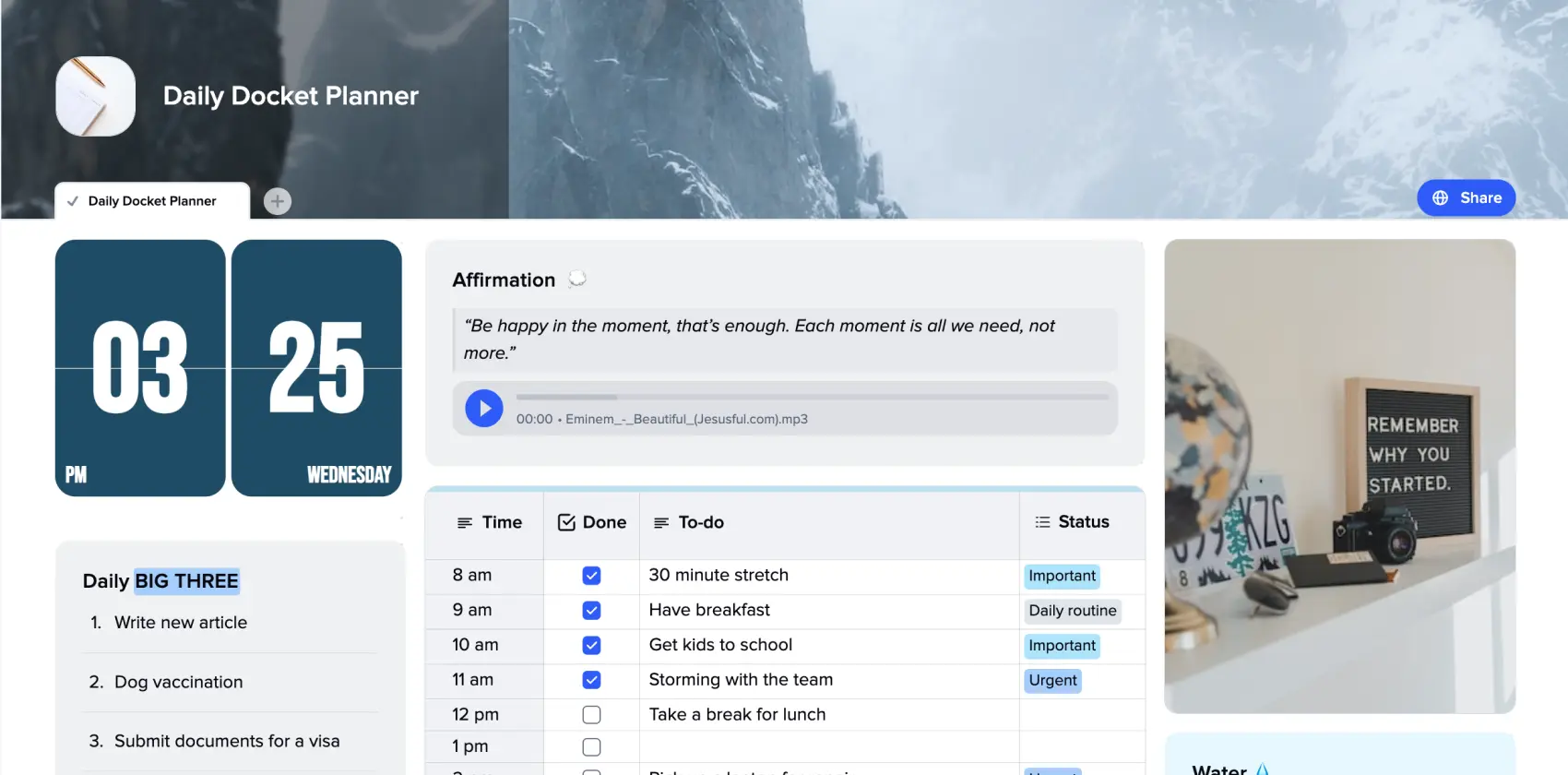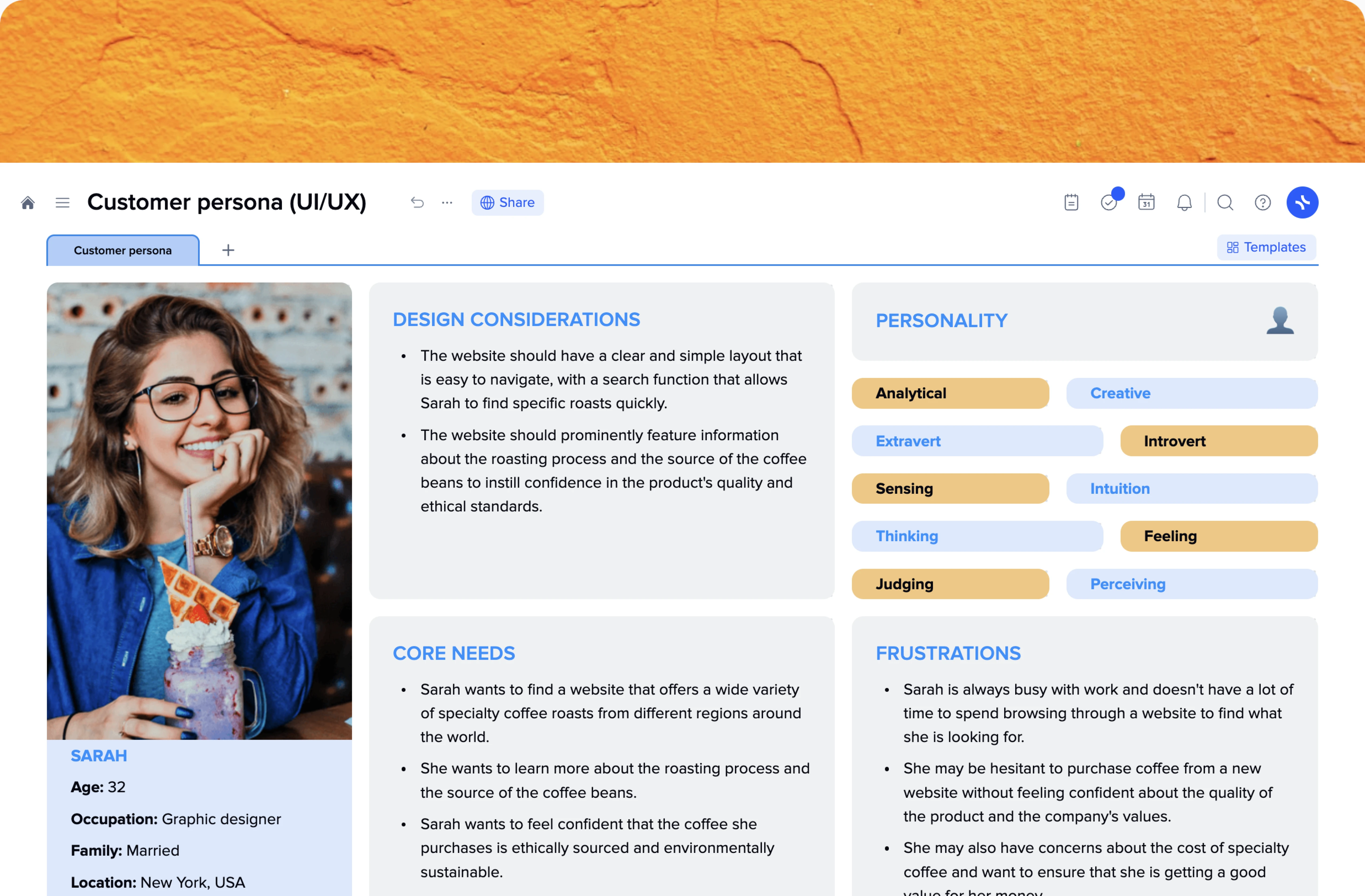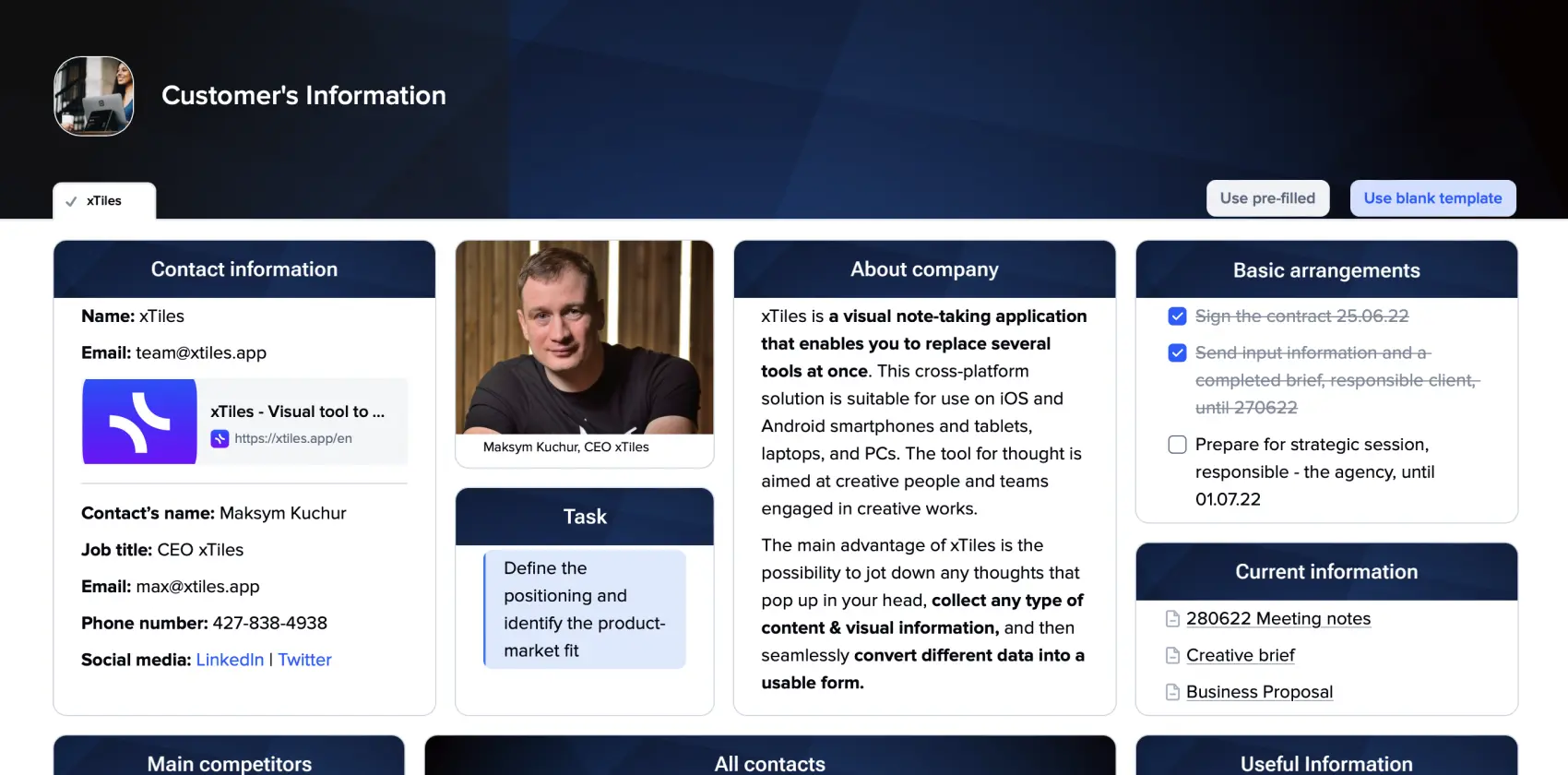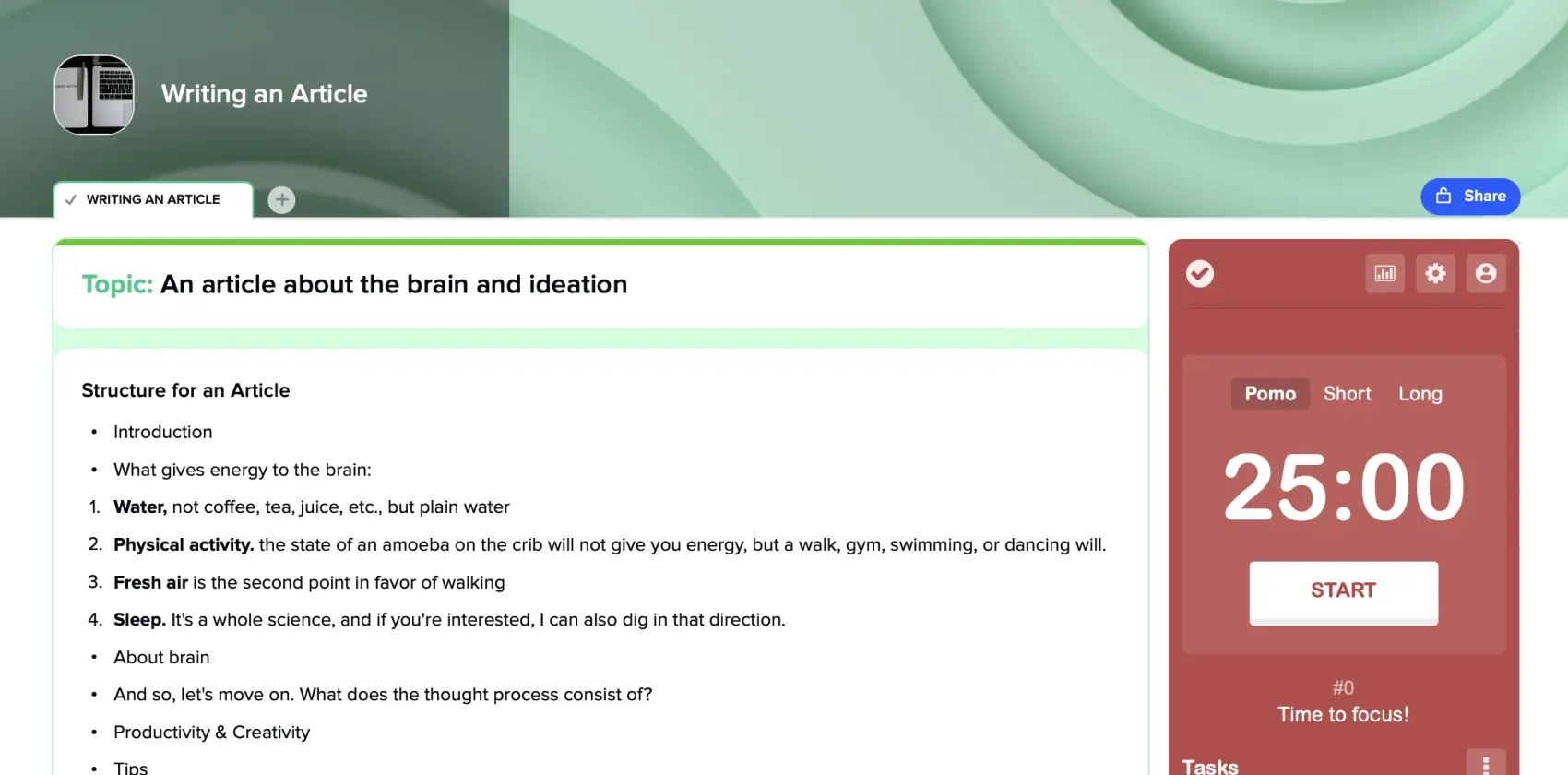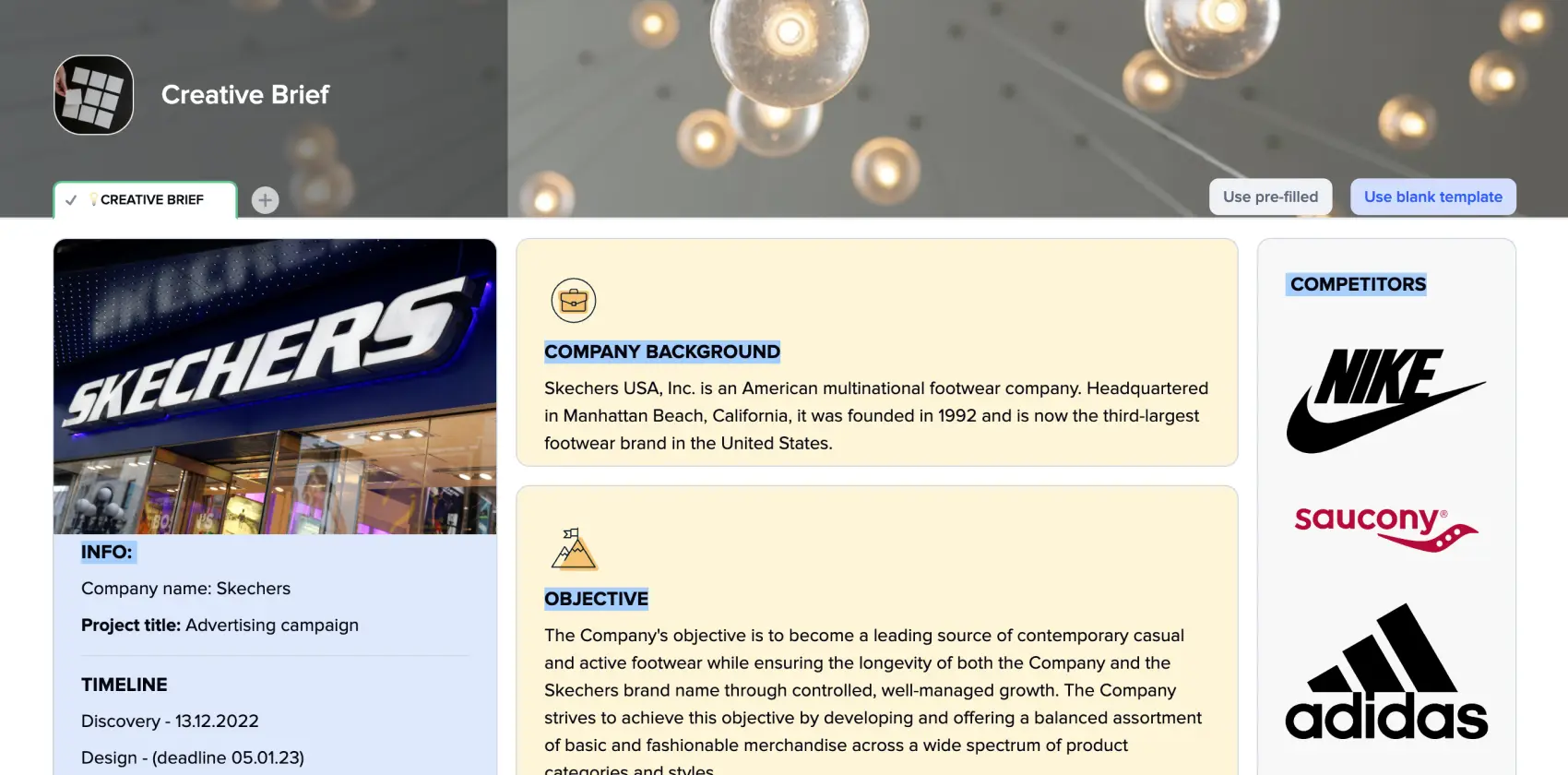Designer Workspace
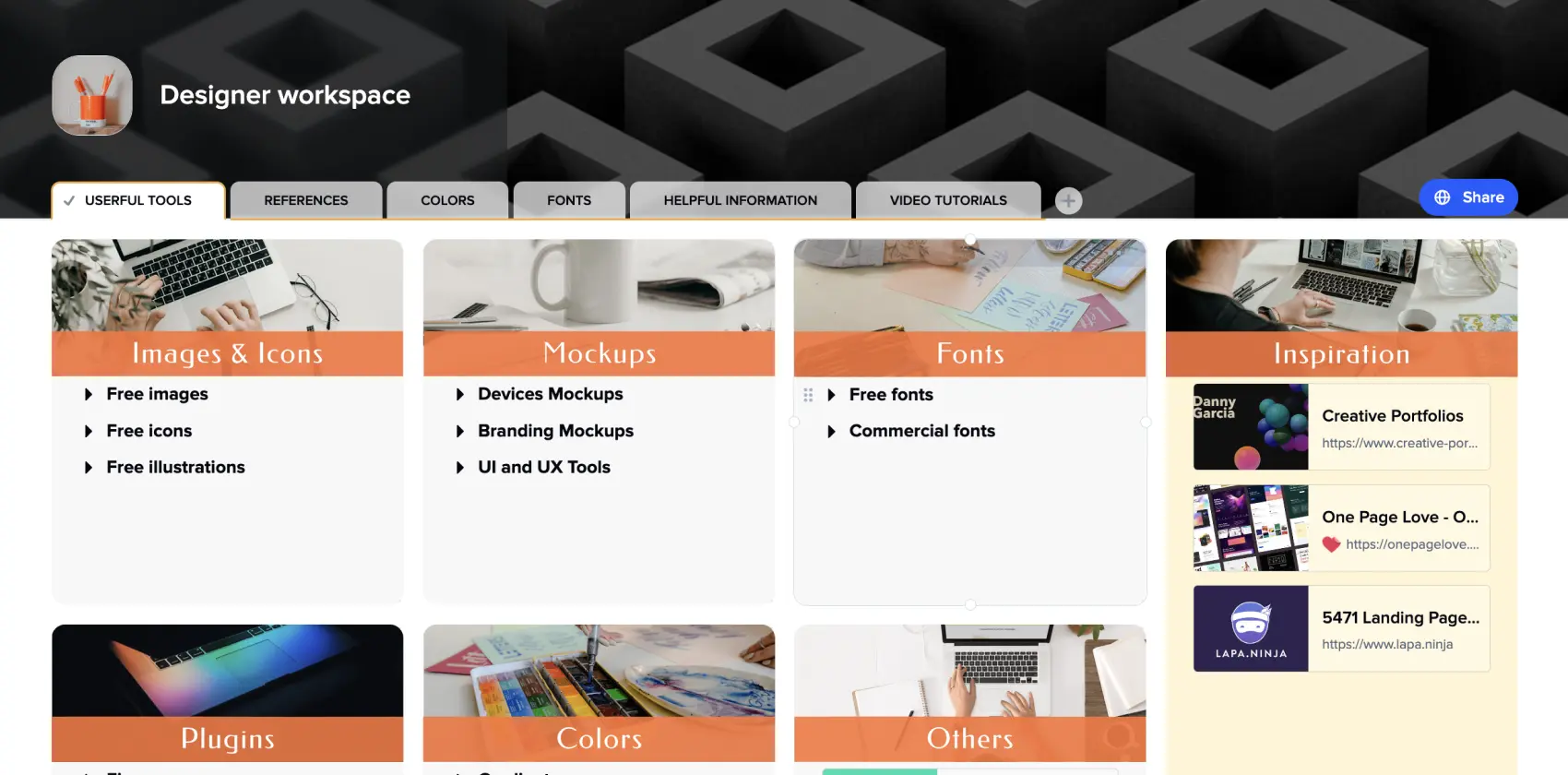

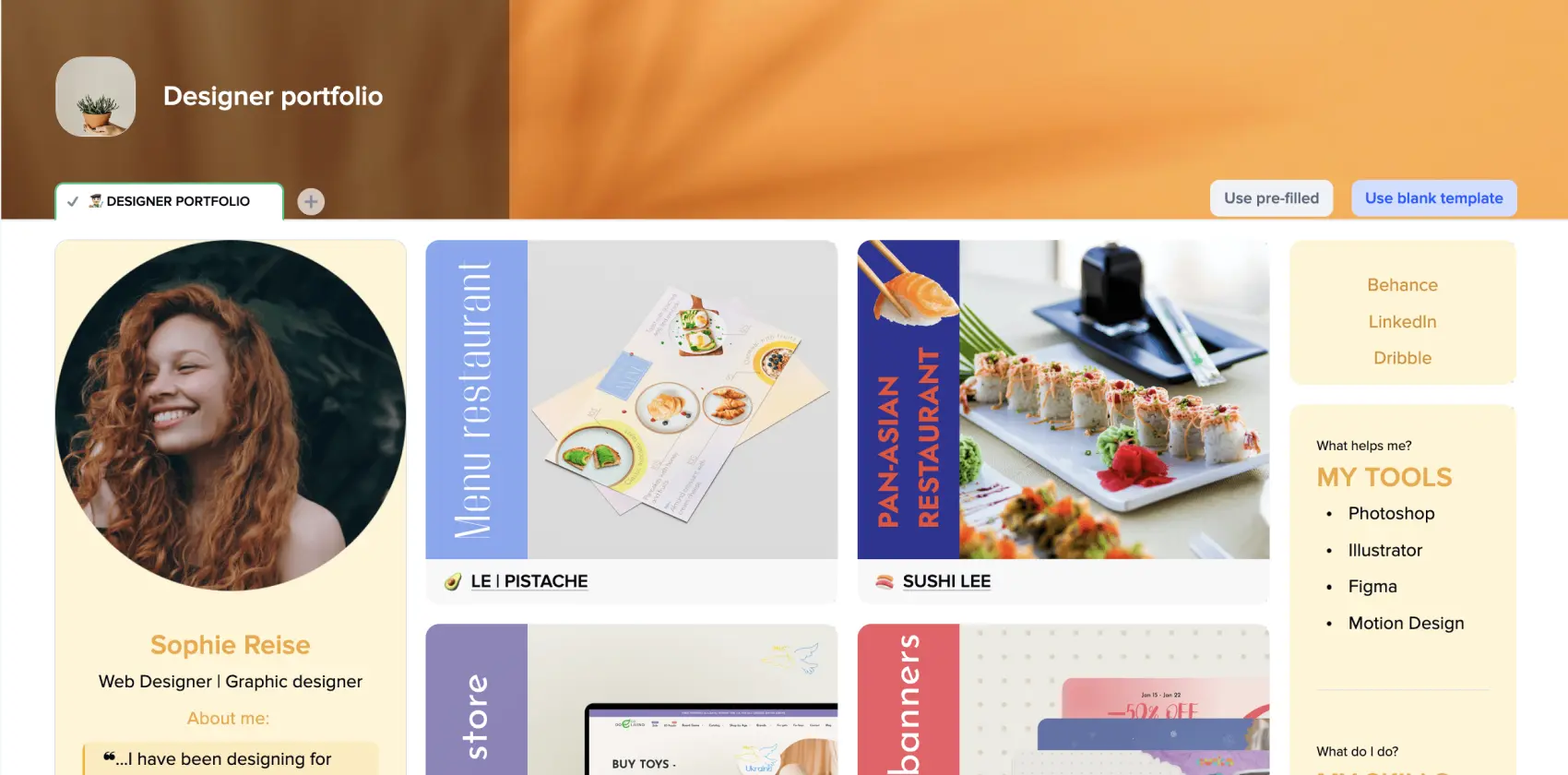
A graphic designer portfolio is a necessary tool for standing out and being in demand. Your work is the best representation of your design skills. And it may be the best argument for someone to hire you.
Proving its owner’s expertise, skills, and experience and showcasing its owner’s creativity and unique vision, a designer portfolio helps gain new interesting projects, new clients, get a dream job, etc. In other words, your portfolio is your pass to further development and growth in your field.
Being a designer, whether we speak about a freelance artist or someone looking for a job in an agency or company, you need to take your portfolio seriously. What does it mean? Keeping it up to date releases you from hastily last-minute preparation.
A free graphic design portfolio template saves time when you regularly update your portfolio and also saves you when you need to show your previous works, but there’s nothing ready and structured.
xTiles offers you a ready-to-use portfolio template for graphic designers to ease the process of looking for new projects or job positions, structuring your previous work, and showcasing your talent, unique and unorthodox approach to work, creativity, and ability to find the best design solutions for complicated questions.
If you’re a graphic designer, you can live without a portfolio. However, your success and new projects will be less likely.
Before anyone hires you to work for them, you need to prove you can manage the task the way they want. Otherwise, you both will be quite frustrated because of constant misunderstandings and false expectations, neither of which can be met.
However, finding just a client or employer isn’t the only purpose of your portfolio. It helps you find a person who can feel your vibe and style, the person who is unlikely to force you to create designs that don’t suit your vision.
Your portfolio is a part of the contract where both are assured that your goals match.
Also, when you see a great yet specific job ad, you can use a portfolio template to show your potential employers examples of similar or related projects if you have them.
When you work for an agency or company, you can relax a bit, at least until you’re not looking for a new position. Freelance designers need to update their portfolios regularly.
If you’re a freelance graphic or UI/UX designer, whether you have or not a portfolio of your previous work might have an effect on how many new projects you get.
Being a designer may play a cruel joke on a person. Creating exciting designs for others, a person might not have time to create their own portfolio that would be convincing and impressive.
Thankfully, ready-to-use design portfolio templates save time and ease the process for all design cases.
Designers from other fields like fashion or interior design can use the benefits of ready-to-go pre-designed templates for showcasing their previous achievements as well. They can expect the same benefits as designers in the IT sphere.
However, suppose you can’t find a specific template like a fashion designer portfolio or interior designer portfolio. In that case, you can always use basic editable templates and adjust them to your specific needs and your field.
There are many things to consider before you start building your portfolio, even if you’ve decided to go with a ready-to-use template. These first steps may have a dominant effect on the outcome and whether you will meet your goals with your portfolio or not, so we recommend paying attention and being careful.
The beginning might be the hardest part because there’s a lot to decide. Many people, even experienced and tough design artists, might get stuck in this phase. That’s why we offer you a detailed guide you can apply to our ready-to-use free graphic design portfolio to get the maximum.
What, in your opinion, will be the natural continuation of your portfolio? A job offer? Many new clients stand in a line waiting till you can start their project? A freelance graphic designer’s portfolio differs from one a person who works in a company should have. Being involved in the marketing process, you should understand that any product (in this case, your portfolio) has to strike straight into the target audience’s minds and hearts.
If you’re creating a portfolio to get a job in an agency or company, showcase work that was created within the context of a team or organization. In case you have been an independent contractor during all of your career but now you want to join a team, demonstrate larger projects or campaigns that had involved cooperation with other marketing specialists.
If you’re creating a portfolio as a freelancer, showcase work that describes you as a highly versatile and flexible artist. Show many contexts and how you managed them in your designs.
If you’re not sure about your intent, you may get two different portfolios and use them according to the situation.
And suppose there are no old projects to put into your portfolio because you’ve only started your graphic design career. In this case, create something that will be representative of your skills and style.
Your portfolio can correspond to your designs. However, if there are many different examples to showcase you as a multifaceted artist, it might be challenging.
Also, we don’t recommend distracting people from your work. That’s why a flamboyant or too expressive design of the portfolio document might play a bad trick to its main subject – your works.
The structure and design we offer you in our template is simple to grasp yet not boring. It helps to keep the reader’s attention on what is important – your work. However, it’s also highly editable and easy to customize, so that you’re free to come up with your own solutions to present your work in the best possible way.
Many people still consider portfolios to be a folder with printed examples of previous projects. Thankfully, today it’s not true most of the time. No tree has to die to help you find a job.
The best way to make your portfolio accessible for as many prospect clients as possible is to have it available online. For example, the xTiles graphic template allows sharing with anyone on the internet and the ability to edit. In other words, you don’t have to upload a new file each time you add a new project or concept art.
Yes, you need to prove your professionalism and wide experience but you don’t need to scare your potential client with a pile of everything everywhere all at once.
First of all, you will need to structure all that you’re about to show and chronological order might not be the best one as your first work might not have enough potential to convince someone to hire you. Besides, structuring everything might take a lot of time, and we’re here to save it.
Then, even if you manage to compile all of your examples in a nice and attractive way, a person might not have enough time to go through all of them. So, we recommend remembering one of the fundamental rules of design – white space will do good. Don’t consider every empty zone of your portfolio a disadvantage as it makes it lighter and more elegant.
As we already mentioned above, throwing all that you have into your potential client is not the best way to at least keep their attention. Resist the temptation to add as many pieces of your previous work as possible. Instead, concentrate on quality.
Choose only your best work. It might be really hard because all of them seem special. However, a few great examples may be enough to convince someone that you are the perfect choice.
Besides, you can present them with other projects during the interview.
Also, it’s important to remember that quality is also about your pieces. Let the digital content you choose for your portfolio will be of high quality, so that people can make out all the details. xTiles allows you to upload files up to 500 Mb in free tier.
When your portfolio has played its role and you got what you wanted, don’t put it off until you need it again. Keep it up to date regularly. Add your new projects. Maybe you don’t consider the old examples to be representative anymore, so replace them with newer ones.
Also, it’s important to update your contact information too. It might seem like you’re invisible to clients when in reality there are a lot of people who would want to work with you, but they can’t reach out to you.
A graphic designer portfolio is supposed to sum up your experience and show why you’re the best suitable candidate for the job. It’s not the same as the resume, yet for many it plays a double role. That’s why it’s important to treat your portfolio with care.
Details are very important. They can ruin everything or spoil your portfolio making you an unattractive candidate. So, we made a list of things for a graphic designer to avoid when building a portfolio.
You don’t need to distract your potential client from your work examples. When providing them with context for each project, try to be laconic. Give only the main points, the rest can be discussed during an interview.
Unnecessary details won’t show that you’re willing to talk about your projects. On the contrary, it might represent your lack of self-confidence. Let your work speak for itself and leave people room for their own interpretation.
Also, don’t forget to check your text on typos and grammatical errors. Even though you’re not trying to get a job as a copywriter or a proofreader, mistakes might represent you as a person with a lack of attention to detail.
Even if you have a resume and usually send them both, add your contact information to your portfolio too. Documents might get lost, but a small section for your phone number and email in your portfolio may be an immediate response to someone’s impulse to choose you.
If you’re a person who can’t praise themselves but waits for others to recognize your work worthy, it would be better to not follow this line in your portfolio. That’s the exact place where you must show off. Otherwise, how else can your clients learn what a great graphic designer you are?
Don’t forget about your photo. Let them see what person stands behind these designs. It will help to break the ice, and the moment you meet for the first time, whether in real life or in Zoom, your face won’t be the face of a stranger to your interviewers.
Additionally, you can add a photo in the style of your designs, creating the red line that leads from your work to you as a personality.
You may go further and include to your designer portfolio a short video about your work and why you love it. Don’t be shy or afraid to tell people why you’re passionate about your work. Clients and employers are more likely to work with artists who are willing to speak about their job.
When choosing your best work, don’t choose only those that are dedicated to a similar subject or were created for one project. Try to show different examples, proving that you’re flexible and can handle tasks of different kinds.
It won’t ruin the consistency of your portfolio. On the contrary, it will prove that you have a unique style that is easy to detect in all of your projects.
Seeing how you work and how you approach design problems may be a serious argument for hiring you. Your sketches, ideation process, and prototypes you create are important to understand what kind of a worker you are.
You may add a link to your personal blog on Instagram or Behance where you show how you work, your results, your failures and how you solve them.
Also, don’t neglect to add your self-initiated art to your portfolio if you consider it’s a great example of your professional skills and style. That is especially important for novice designers who don’t have a lot of experience and projects under their belt.
Important to remember that junior designers’ portfolios sometimes 100% consists of self-initiated art, but that doesn’t mean they don’t get offers. That’s why don’t be afraid to start!
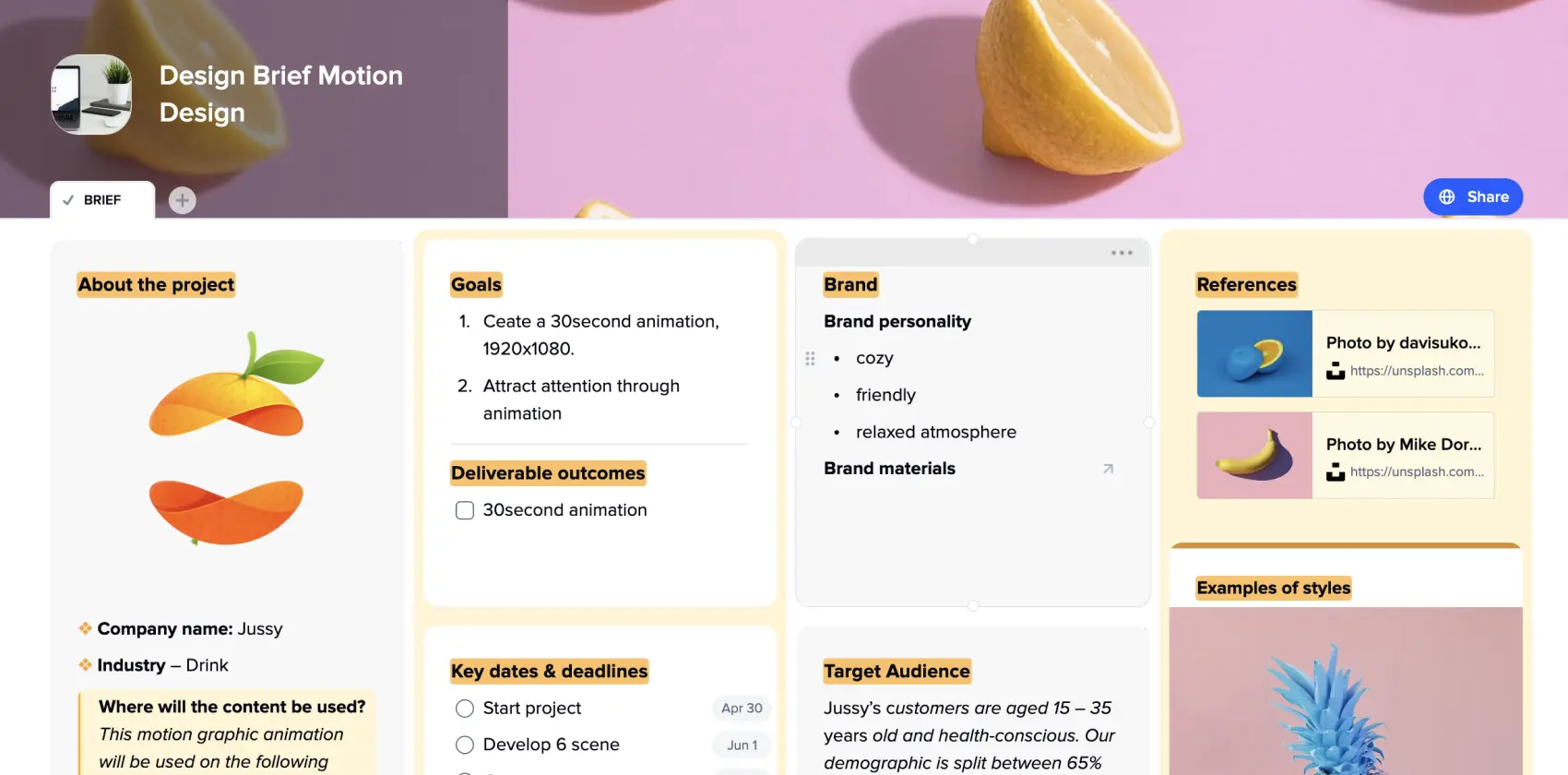
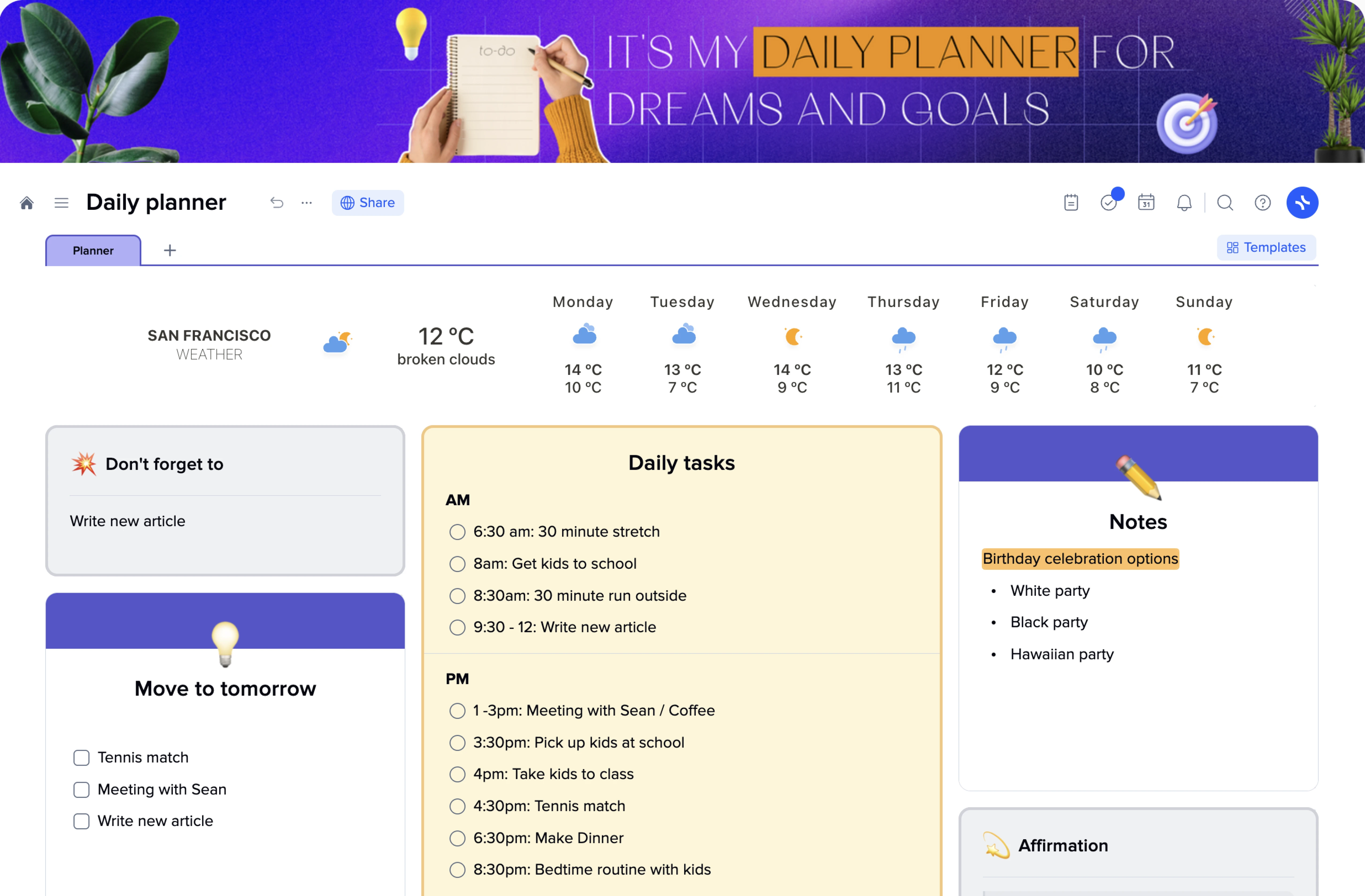
Whether your day will be productive and great depends on many factors, and not all of them depend on you. However, there are many ways to ensure you will use these 24 hours to your advantage fully.
A daily planner is a tool to organize and plan out tasks, appointments, and activities for a given day. It helps ensure that you remember important tasks or appointments. It can also help you prioritize your activities and make sure that you’re spending your time on the most important things.
Daily task planners can be of two types – physical or digital. The first one slowly but steadily gives up on digital planners due to a lack of customization and editing futures.
A daily planner template is the next step of planner evolution. It provides users with pre-designed calendars that often include sections for different categories, such as work tasks, personal errands, exercise, and meals. Some daily planners also have space for notes, goals, and priorities, which can help you stay focused and productive throughout the day.
The xTiles Daily Planner is the perfect tool for arranging your day easily. However, to make your plan feasible, we also offer a guide on how to make your daily planner and an example of a daily planner.
Let’s create your best daily planner!
The choice between a digital or printed daily planner ultimately comes down to personal preference and the time and patience they have to write down every daily goal and task.
Digital daily planners offer several benefits:
A daily task planner may be printable, which has some benefits too. For example, daily planners in pdf are quite popular for their designs. Writing things down by hand has been shown to improve memory and cognitive function. Some people claim that printed planners also offer a greater sense of satisfaction and accomplishment when they physically cross off completed tasks.
A digital daily planner may be a more beneficial option for people who value accessibility, convenience, efficiency, and customization options over the special vibe a notebook planner may bring. However, it ultimately comes down to personal preference, and some individuals may still prefer a printed planner for their planning needs.
A person can benefit from using a daily planner template in many situations. Overall, everyone will find something useful in regular planning. The more tasks a person needs to manage during a day, the more they need a planner to keep everything in their mind. The more tasks a person needs to manage during a day, the more they need a planner to distribute their tasks evenly.
It may be especially helpful for those who rely on their memory and improvisation and those looking to improve their time management skills, increase productivity, and reduce stress.
One of the main benefits of using a daily planner template is that it helps people manage their time more effectively with less effort. By allowing one to schedule a day and prioritize tasks, an online daily task planner ensures that the time is used in the most efficient way possible. Those with busy schedules or many responsibilities to manage during the day may find it helpful.
A daily planner template also helps people to increase productivity while protecting them from burnout. One can accomplish more in less time if staying focused and organized and not wasting time finding out what to do next.
People who have a lot of tasks to complete, or especially those who are working on important projects that require a high level of concentration, may find a planner to be a huge support.
A daily planner template can be an effective tool for people who prefer to set their tasks and goals in one place and track them easily.
Many people believe that daily planners are worth nothing in the long run. However, making and using them can be particularly helpful for those working towards long-term goals, such as starting a business, learning a new skill, or completing a degree program. They become a very detailed documentation of progress and help to analyze actions for further planning.
A planner allows breaking down big goals into smaller, actionable steps so that you can stay motivated and on track during the day.
Using a daily planner template can also help reduce stress and anxiety people may experience without a strict plan or when they don’t know how to plan effectively.
If a person knows exactly what they need to do and when, they are more likely to avoid the stress of forgetting important appointments or deadlines. That can be especially beneficial for those who struggle with anxiety or have many responsibilities to manage.
Finally, daily planner templates are useful for managers or those in leadership roles in their ever-lasting struggle to delegate tasks and ensure everyone is on the same page.
In conclusion, a daily planner template may come in handy to anyone who wants to improve their time management skills, increase productivity, and reduce the stress they usually face because of a lack of planning or a lack of knowledge on how to plan effectively. Whether you’re a student, a professional, or simply looking to stay organized, a daily planner template can help you achieve your goals and stay on track.
Additionally, it’s important to know that people don’t have to be a CEO of a huge corporation to consider themselves a busy person who needs a planner. Starting from school students and finishing with a part-time job of any kind, a daily planner is a tool to help you manage your tasks and appointments, whether there are only three or fifteen of them, more efficiently.
A daily planner helps keep track of schedules, tasks, meetings, appointments, deadlines, goals, etc. Since daily planners are hugely personal, there’s no one-fits-all list that everyone can put into their planner.
What a person includes in their daily planner will depend on their personal needs and preferences, but some common items can be useful to include.
First and foremost, you may create a to-do list. That should include all the tasks you need to complete that day, prioritized based on their importance or urgency. That may help you stay focused and ensure you use your time efficiently.
Next, you may note any appointments or meetings scheduled for the day. It may be helpful to include the time and location to arrive on time and prepare.
If you have any important reminders or deadlines that you need to remember, write them down as well.
You may also want to set specific goals for the day. That could be a particular task that you want to complete or a goal related to your personal or professional development. Writing down your goals can help you stay motivated and focused throughout the day.
If you plan to prepare meals or snacks for the day, you may write down what you plan to eat and when. That section may become essential for people who must follow some dietary restrictions or try to stay on track with their nutrition and avoid last-minute decisions that may not be the healthiest.
You may also add your planned exercise or physical activity. That may help you prioritize your health and well-being and ensure you’re making time for movement.
Finally, include space for notes or ideas that come up throughout the day. They may be ideas for the next day’s planning and be a helpful way to jot down important information or inspiration that you may want to revisit later.
Remember, your daily planner should be a tool to help you and only you stay organized and on track. No one will see it unless you decide to share it. So, let peer pressure not define what you put in your daily planner. Do you want to schedule your leisure time? You’re welcome!
Additionally, your daily planner must not become a source of stress. If you feel overwhelmed from checking it, then you need to review your approach to planning.
Keep your planner manageable and realistic, and adjust it as needed throughout the day.
Creating an effective daily planner involves several steps. However, your planner will depend on what sections you want to include. The xTiles Daily Planner Template can be customized according to your planning needs.
Also, not all the days are the same. If yesterday you were exceptionally busy and productive, today you may feel less energetic. A planner will help to organize your day depending on your current potential.
There are two main approaches to creating a plan for the day. Some people prefer to end their days by planning the next ones. Some people start their days by planning what they want to manage today.
If you have never used planners, you may try both of these approaches to find which one suits you best.
Start with defining your goals. That will help you to focus on the most important tasks and avoid wasting time on less critical activities.
You may prioritize a task or two and put them into the “Don’t forget” section. It’s important to remember that not all of your tasks or goals deserve to end in that section. Some of them are meant for the “Daily tasks” part.
When scheduling your tasks and routine, you may divide your day into AM and PM to better understand what you need to accomplish. Daily hourly planners help people keep their focus throughout the day.
If you have a large project or task to complete, break it down into smaller, more manageable tasks. That may turn an overwhelming task into an easier-to-accomplish one.
It’s essential to take breaks throughout the day to rest and recharge. Otherwise, you may not finish everything you planned simply because you lack energy. Schedule breaks into your planner, and take them when needed during the day.
Add details regarding your tasks into the “Notes” section of your planner. That may be something you need to take to your meeting, something you want to ask someone or check later. Write down all of your ideas to have them handy.
Another important part of a planner is daily affirmation. It may sound like something unnecessary for successfully accomplishing your daily tasks, yet it may inspire you to move and tune in to the process.
Your daily planner doesn’t work on its own. It’s a part of something much greater – your week or month. That’s why we offer you to add your monthly priorities to your daily planner to have in front of you what you’re striving to accomplish or what you can’t forget at any cost.
The last sections are exactly what makes digital planners and daily planner apps more beneficial than printable ones.
You may add links to websites or files you will need during the day or something interesting you come across. And you may add pictures to adjust your daily planner to your mood or to create the atmosphere you want.
Review your planner at the end of each day and assess how well you accomplished your tasks. At this point, your planner becomes the greatest tool to learn more about yourself and your inclinations.
It will help you better understand yourself and your potential, when you’re more productive, what brings you energy and what steals it from you, etc. Make adjustments as necessary to improve your productivity and efficiency in the future.
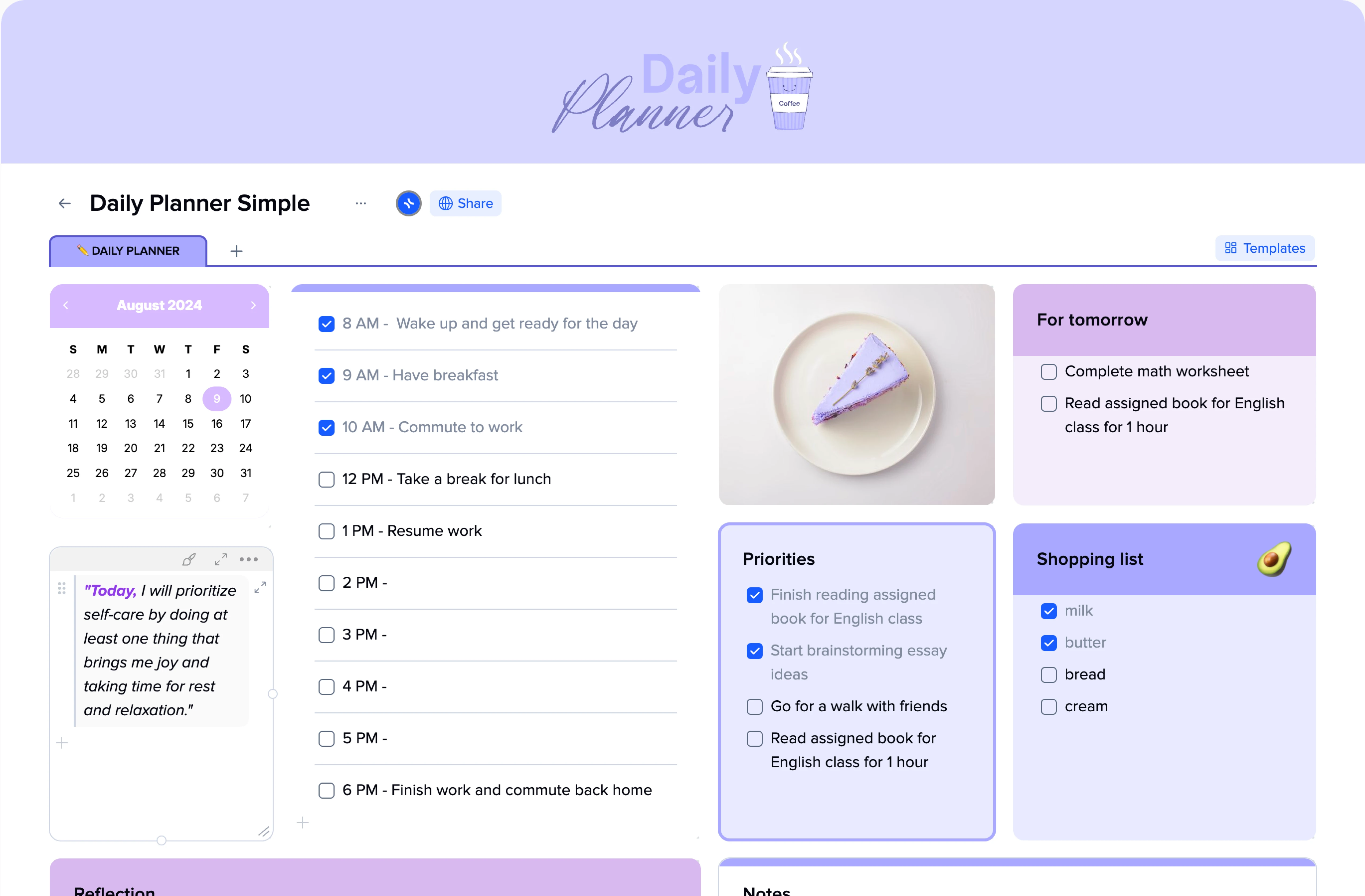
Whether your day will be productive and great depends on many factors, not all of which depend on you. However, there are many ways to ensure you will fully use these 24 hours to your advantage.
A daily planner is a tool to organize and plan out tasks, appointments, and activities for a given day. It helps ensure that you remember important tasks or appointments. It can also help you prioritize your activities and make sure that you’re spending your time on the most important things.
Daily task planners can be of two types – physical or digital. The first one slowly but steadily gives up on digital planners due to a lack of customization and editing futures.
A daily planner template is the next step of planner evolution. It provides users with pre-designed calendars that often include sections for different categories, such as work tasks, personal errands, exercise, and meals. Some daily planners also have space for notes, goals, and priorities, which can help you stay focused and productive throughout the day.
The xTiles Daily Planner is the perfect tool for arranging your day easily. However, to make your plan feasible, we also offer a guide on how to make your daily planner and an example of a daily planner.
Let’s create your best daily planner!
The choice between daily planner printables and digital planners ultimately comes down to personal preference and the time and patience they have to write down every daily goal and task.
They are easily accessed and synced across multiple devices (even if you use both iOS and Windows, or iOs and Android), making it easy to keep schedules and tasks up-to-date.
They often have built-in features such as reminders, alerts, and the ability to set recurring tasks.
They offer supportive tools like a habit tracker, all kinds of to-do lists, bills tracker, etc.
Digital planners are often more environmentally friendly than printed planners and notebooks since they don’t require paper.
The layout can be easily edited and customized without harming the overall appeal if plans change.
Daily planner apps help people stay connected with their tasks while on the run and excel in getting things done quickly. It might be quite uncomfortable to carry a notebook or a shit of paper everywhere you go, especially if your job requires a lot of movement.
A daily task planner may be printable, which has some benefits too. For example, daily planners in pdf are quite popular for their designs. Writing things down by hand has been shown to improve memory and cognitive function. Some people claim that printed planners also offer a greater sense of satisfaction and accomplishment when they physically cross off completed tasks.
A digital daily planner may be a more beneficial option for people who value accessibility, convenience, efficiency, and customization options over the special vibe a notebook planner may bring. However, it ultimately comes down to personal preference, and some individuals may still prefer a printed planner for their planning needs.
A person can benefit from using a daily planner template in many situations. Overall, everyone will find something useful in regular planning. The more tasks a person needs to manage during a day, the more they need a planner to keep everything in their mind. The more tasks a person needs to manage during a day, the more they need a planner to distribute their tasks evenly.
It may be especially helpful for those who rely on their memory and improvisation and those looking to improve their time management skills, increase productivity, and reduce stress.
One of the main benefits of using a daily planner template is that it helps people manage their time more effectively with less effort. By allowing one to schedule a day and prioritize tasks, an online daily task planner ensures that the time is used in the most efficient way possible. Those with busy schedules or many responsibilities to manage during the day may find it helpful.
A daily planner template also helps people to increase productivity while protecting them from burnout. One can accomplish more in less time if staying focused and organized and not wasting time finding out what to do next.
People who have a lot of tasks to complete, or especially those who are working on important projects that require a high level of concentration, may find a planner to be a huge support.
A daily planner template can be an effective tool for people who prefer to set their tasks and goals in one place and track them easily.
Many people believe that daily planners are worth nothing in the long run. However, making and using them can be particularly helpful for those working towards long-term goals, such as starting a business, learning a new skill, or completing a degree program. They become very detailed documentation of progress and help analyze actions for further planning.
A planner allows breaking down big goals into smaller, actionable steps so that you can stay motivated and on track during the day.
Using a daily planner template can also help reduce stress and anxiety people may experience without a strict plan or when they don’t know how to plan effectively.
If a person knows exactly what they need to do and when they are more likely to avoid the stress of forgetting important appointments or deadlines. That can be especially beneficial for those who struggle with anxiety or have many responsibilities to manage.
Finally, daily planner templates are useful for managers or those in leadership roles in their ever-lasting struggle to delegate tasks and ensure everyone is on the same page.
In conclusion, a daily planner template may come in handy to anyone who wants to improve their time management skills, increase productivity, and reduce the stress they usually face because of a lack of planning or a lack of knowledge on how to plan effectively. Whether you’re a student, a professional, or simply looking to stay organized, a daily planner template can help you achieve your goals and stay on track.
Additionally, it’s important to know that people don’t have to be a CEO of a huge corporation to consider themselves a busy person who needs a planner. Starting from school students and finishing with a part-time job of any kind, a daily planner is a tool to help you manage your tasks and appointments, whether there are only three or fifteen of them, more efficiently.
A daily planner helps keep track of schedules, tasks, meetings, appointments, deadlines, goals, etc. Since daily planners are hugely personal, there’s no one-fits-all list that everyone can put into their planner.
What a person includes in their daily planner will depend on their personal needs and preferences, but some common items can be useful to include.
First and foremost, you may create a to-do list. That should include all the tasks you need to complete that day, prioritized based on their importance or urgency. That may help you stay focused and ensure you use your time efficiently.
Next, you may note any appointments or meetings scheduled for the day. It may be helpful to include the time and location to arrive on time and prepare.
If you have any important reminders or deadlines that you need to remember, write them down as well.
You may also want to set specific goals for the day. That could be a particular task that you want to complete or a goal related to your personal or professional development. Writing down your goals can help you stay motivated and focused throughout the day.
If you plan to prepare meals or snacks for the day, you may write down what you plan to eat and when. That section may become essential for people who must follow some dietary restrictions or try to stay on track with their nutrition and avoid last-minute decisions that may not be the healthiest.
You may also add your planned exercise or physical activity. That may help you prioritize your health and well-being and ensure you’re making time for movement.
Finally, include space for notes or ideas that come up throughout the day. They may be ideas for the next day’s planning and be a helpful way to jot down important information or inspiration that you may want to revisit later.
Remember, your daily planner should be a tool to help you and only you stay organized and on track. No one will see it unless you decide to share it. So, let peer pressure not define what you put in your daily planner. Do you want to schedule your leisure time? You’re welcome!
Additionally, your daily planner must not become a source of stress. If you feel overwhelmed from checking it, then you need to review your approach to planning.
Keep your planner manageable and realistic, and adjust it as needed throughout the day.
Creating an effective daily planner involves several steps. However, your planner will depend on what sections you want to include. The xTiles Daily Planner Template can be customized according to your planning needs.
Also, not all the days are the same. If yesterday you were exceptionally busy and productive, today you may feel less energetic. A planner will help to organize your day depending on your current potential.
There are two main approaches to creating a plan for the day. Some people prefer to end their days by planning the next ones. Some people start their days by planning what they want to manage today.
If you have never used planners, you may try both of these approaches to find which one suits you best.
Start with defining your goals. That will help you to focus on the most important tasks and avoid wasting time on less critical activities.
You may prioritize a task or two and put them into the “Don’t forget” section. It’s important to remember that not all of your tasks or goals deserve to end in that section. Some of them are meant for the “Daily tasks” part.
When scheduling your tasks and routine, you may divide your day into AM and PM to better understand what you need to accomplish. Daily hourly planners help people keep their focus throughout the day.
If you have a large project or task to complete, break it down into smaller, more manageable tasks. That may turn an overwhelming task into an easier-to-accomplish one.
It’s essential to take breaks throughout the day to rest and recharge. Otherwise, you may not finish everything you planned simply because you lack energy. Schedule breaks into your planner, and take them when needed during the day.
Add details regarding your tasks into the “Notes” section of your planner. That may be something you need to take to your meeting, something you want to ask someone or check later. Write down all of your ideas to have them handy.
Another important part of a planner is daily affirmation. It may sound like something unnecessary for successfully accomplishing your daily tasks, yet it may inspire you to move and tune in to the process.
Your daily planner doesn’t work on its own. It’s a part of something much greater – your week or month. That’s why we offer you to add your monthly priorities to your daily planner to have in front of you what you’re striving to accomplish or what you can’t forget at any cost.
The last sections are exactly what makes digital planners and daily planner apps more beneficial than printable ones.
You may add links to websites or files you will need during the day or something interesting you come across. And you may add pictures to adjust your daily planner to your mood or to create the atmosphere you want.
Review your planner at the end of each day and assess how well you accomplished your tasks. At this point, your planner becomes the greatest tool to learn more about yourself and your inclinations.
It will help you better understand yourself and your potential, when you’re more productive, what brings you energy and what steals it from you, etc. Make adjustments as necessary to improve your productivity and efficiency in the future.
